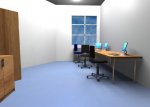McMarbi
0
Arealight and grey ceiling
Can someone say to me, how I create it that the ceiling is also white? I use an arealight with about 50 samples, but the ceiling is always grey.
I'm new to Cheetah 3D and need help in many ways.
My English is bad. Please do not grumble.
Martin
Can someone say to me, how I create it that the ceiling is also white? I use an arealight with about 50 samples, but the ceiling is always grey.
I'm new to Cheetah 3D and need help in many ways.
My English is bad. Please do not grumble.
Martin






